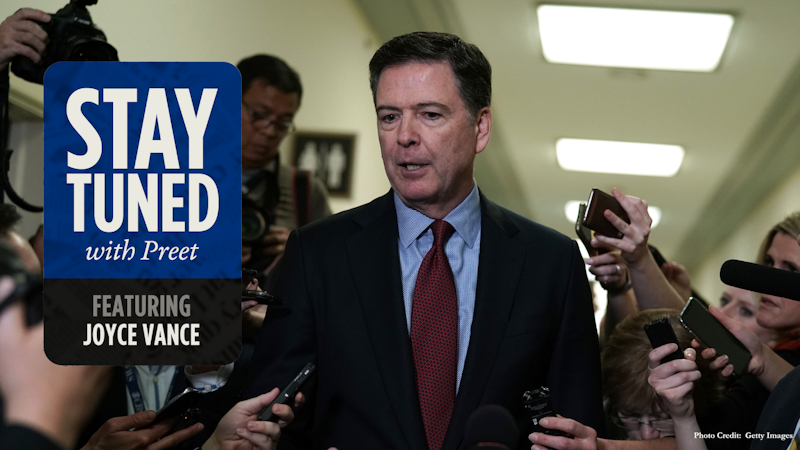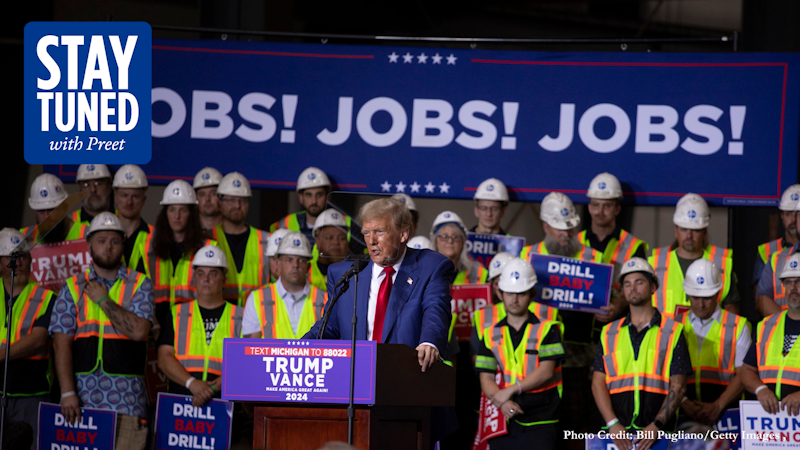Preet Bharara:
From CAFE and the Vox Media Podcast Network, this is Stay Tuned in brief. I’m Preet Bharara. President Biden entered office with big ambitions to combat climate change. So how’s he doing? Well, in recent weeks, the EPA has announced or indicated that it will announce a series of significant policies, one to dramatically increase sales of electric cars and trucks, and another to limit greenhouse gas emissions from power plants. To drill down into these policies, I’m joined by Coral Davenport. She’s a reporter at The New York Times where she covers energy and environmental policy with a focus on climate change. In 2020, she was a finalist for the Pulitzer Prize. Coral, welcome to the show.
Coral Davenport:
Hi. Great to be with you.
Preet Bharara:
So let’s start with the electric vehicles announcement and policy. What exactly will it do and how ambitious is it?
Coral Davenport:
So the EPA regulation, it’s actually a regulation on greenhouse gas emissions from vehicles which are currently vehicle tailpipes are the largest source of greenhouse gas pollution in the United States. And the restriction, the limits on greenhouse gas pollution are designed to compel automakers to basically rapidly switch over the kind of cars that they are selling, such that by 2032, about 67% of new car sales in the US are all electric. That is a massive leap. That’s up from about 6% today, so.
Preet Bharara:
6% To 67%.
Coral Davenport:
That is like a tenfold increase in less than a decade.
Preet Bharara:
If I’m doing the math correctly, that’s like nine years. So interestingly, as you point out, the EPA is not mandating a particular number of cars switching over to electric because they can’t do that or because they prefer not to do that.
Coral Davenport:
Correct. No. I mean the EPA, it’s the Environmental Protection Agency. So what they can regulate are emissions. That’s sort of their brief. They can’t mandate numbers of car sales. But what they can do is tell the regulated entities, which are auto companies, automakers, they can say, each year you have to show the EPA, that the average number of emissions produced by the new cars that you sell goes down really fast. The numbers go down each year. And so essentially the only way that automakers would be able to comply with this regulation is by really rapidly increasing the number of zero emission cars that they sell. That is the form of compliance. So that is the outcome of the regulation.
Preet Bharara:
What is the enforcement mechanism? What is the penalty if GM or some other automaker falls short?
Coral Davenport:
Sure. At the end, so once these rules go into place, at the end of each year, a company like GM or Ford would report back. They would say, okay, this is our annual sales of new vehicles. Again, important to remember, this only applies to sales of new cars. And say, we’ve sold this many Chevy Silverados, which is not GM, or I’m thinking of Ford F-150, sort of the biggest seller cars or these big gas guzzling pickup trucks. We’ve sold this many of this, we’ve sold this many of this, and so what is the overall average number of emissions produced by all the cars that we sell? And if those numbers are higher than the regulation, then the companies have to pay pretty hefty fines. They’re given a year or two to make up for it.
So if in one year they go over, they’re given, you can make it up by going under in the next year or two. But if they do not comply and they don’t meet those numbers overall, then there are fines that can go in the billions of dollars. I mean, it’s designed to have teeth and to have hurt and to make it very, very compelling for the automakers to meet these regulations rather than just pay their way out of it.
Preet Bharara:
Designed to hurt. Are the rules designed to cause automakers to sort of incrementally increase every year? Or is it back loaded or is it front loaded or how does that work?
Coral Davenport:
It’s steeper each year. So the closer you get to, I think close to 60% by 2030 and then 67% by 2032. So the requirements get steeper as the years go on.
Preet Bharara:
You have written that this is nothing short of a revolution in the US auto industry. Has there been something comparable to this, either in environmental regulation or something else that comes to mind?
Coral Davenport:
If this regulation, and these are very important ifs, if this regulation is legally finalized in the way it’s proposed, right now, it’s a draft proposal. If it is implemented and super, super important, if it stands up to legal challenges and a future administration. If it stays in place and is enacted, it would fundamentally transform one of the bedrock industries, not just of the US but the global economy. And certainly within the auto industry, there’s no one I’ve talked to who hasn’t said this is on par in terms of the technological change and challenge, this is on par to the change that came in the auto industry as a result of Henry Ford inventing the assembly line 100 years ago. Every automaker, auto workers have said this changes everything.
Preet Bharara:
Is the point here to do something very, very dramatic, understanding that it’s unrealistic, but pushing people as far as they can go with maybe an eye towards in the future, relaxing the requirement a little bit or do they mean business and really going from 6% to 67% in nine years?
Coral Davenport:
So I think this administration absolutely means business. And I don’t actually think it’s unrealistic for a couple of reasons, but I should say one again, this is a draft proposal, and they’ll put out the final rule in a year. And the way these government regulations work is they’ll put out a draft, they’ll take public comment, the auto industries are all going to come in and they’re going to say, this is too much, it’s too hard, it’s too fast. They’re going to say that.
Preet Bharara:
Well, not all of them. Tesla’s not going to say that.
Coral Davenport:
Tesla won’t, but a lot of the other ones will certainly Stellantis, which makes sort of the lowest fuel economy cars in the US is likely to say that. The automakers will say that, and they always do. Every time they get an environmental regulation, they always say that. So they’ll listen. And it is certainly within the realm of possibility, I think that they will somewhat lower the ambition of it. And that’s kind of a common way that environmental regulations go. They’ll sort of put out, here’s the high water mark of what we want, and then when they finalize it, it’s a little easier.
Once it’s finalized, I do think there is the expectation that they would want it to be met. But a really important thing is that this regulation and the ambition of this regulation do not come out in isolation. And there’s no way that the administration would’ve come out with such an ambitious regulation if it was not also paired with the new law creating massive incentives for consumers of electric vehicles that was passed last year. So that’s the Inflation Reduction Act, passed in 2022. That includes tax incentives for buyers of electric vehicles to make them more attractive, up to $7,500 for purchasers of vehicles.
Preet Bharara:
So these things go hand in hand.
Coral Davenport:
They go hand in hand. I mean, the idea was basically first they pass legislation to create carrots for consumers, to make consumers want, to get free money for buying electric vehicles. And then they put forward this regulation that essentially created a stick for the automakers to say, you have no choice but to do this.
Preet Bharara:
So here’s my question. They mandate certain emissions, they provide incentives for folks to buy electric vehicles, but how much does the infrastructure have to change in terms of charging stations in the country to go from 6% to 67% in only nine years? And what’s the plan for building those charging stations?
Coral Davenport:
Yeah. So the infrastructure is a huge, huge, huge challenge. And again, part of the reason that we see the administration thinking that such an aggressive, ambitious regulation is doable is because of another law. That’s the 2021 infrastructure law that included about $7 billion to build half a million electric vehicle charging stations on interstate, on interstate highways, on big federal highways. So that,
Preet Bharara:
Was that enough?
Coral Davenport:
No.
Preet Bharara:
Okay.
Coral Davenport:
Not even,
Preet Bharara:
I have no sense of the scale and the number.
Coral Davenport:
No. Right.
Preet Bharara:
How many do we need?
Coral Davenport:
So an analysis by S&P Global found that we would need, for not even the amount of electric vehicles that they’re talking about at the scale. I think if it was like 40 for to 50% of new cars sold were electric vehicles, we would need about at least three million charging stations. And so the federal government has stepped up and said, we’ll pay for half a million. The real need is probably more than three million, three, four, five million. And that’s public charging stations. That’s not even talking about what’s needed in garages, what’s needed in apartment buildings, what’s needed. I can’t have an electric vehicle. I live in a city row house. I would no place to plug it in.
And the administration is acknowledges that there is this chicken and egg situation with the cars and the charging stations and a lot of anxiety from consumers like, yes, I could get this tax credit, but where do I plug it in? What if I drive somewhere? What if I’m out in the middle of nowhere and I need to plug and charge and I can’t do it? And so there is a sense when I talk to experts in this industry, they say the charging stations probably have to come first. We need to see municipalities. We need to see cities starting to build more and more charging stations so that they’re there even before the cars and the drivers are there.
Preet Bharara:
Is part of this related in some way, and this is just a guess on my part, but it’s part of this related in some way to the expectation of what battery technology is going to be like over the next nine, 10 years?
Coral Davenport:
It is, absolutely. And the battery technology is very good. And here’s another point where I want to explain why the administration feels confident that this is a realistic and achievable goal, and this is what they say, and they have a big analysis that explains it. The federal government has an auto technology lab up in Ann Arbor, Michigan, right near where all the big automakers of course have their headquarters and their big manufacturing facilities. And the job of this auto technology lab is to basically get all the most cutting edge cars that are already on the road, take them apart, talk to the engineers in the different companies, work with, sort of understand all the technology that is available, that is proprietary, that the companies don’t even know that the other companies have, talk to engineers and figure out. And I went and I visited this lab and they said, look, we know what the car companies can do, even if they don’t all know what their competitors can do. We know what technology is already available and where it’s going and how much it can cost and that,
Preet Bharara:
So where’s battery technology going?
Coral Davenport:
So what these engineers at this lab said is, we are confident that the battery technology is already either where it needs to be or on track to get where it needs to be to have long range batteries that are affordable by the time the regulations say they have to be there. So this kind of research really underpins the target that they’re setting.
Preet Bharara:
Right. So to be clear, what we’re talking about is improvements in battery technologies such that charging takes less time and a charge lasts longer.
Coral Davenport:
And they’re affordable.
Preet Bharara:
And they’re affordable.
Coral Davenport:
And they do take that into consideration as well.
Preet Bharara:
So these rules are clearly going to be attacked and are already under legal attack. What’s the nature of the legal attack and what’s the likelihood of success?
Coral Davenport:
So there’s this group of, as I’m sure you are familiar with, this well organized group of attorneys general from Republican states who have been very consistently filing lawsuits against pretty much every major climate change and other, but I follow the climate change, every major sort of climate change regulation or climate change step that this administration is taking. They had great success in front of the Supreme Court last summer with a Supreme Court decision that really handcuffed the EPA’s ability to go after another major source of carbon dioxide emissions, which is power plants. They said, you can do it, but you have to be very limited. You can’t be creative. We’re going to be watching you essentially. And so this will be sued, I think it will also be sued probably by oil companies since one of the points of the acceleration into electric vehicles is to end the use of petroleum.
And I fully expect that a lawsuit against this and the other major climate regulations will probably end up in front of the Supreme Court. And this Supreme Court has shown itself to be very skeptical of aggressive and ambitious environmental regulations. That said, the Clean Air Act, which is the statute that is the foundation for this regulation, is pretty clear that the federal government does have the authority to limit these emissions. And sort of the question will be, did they go too far? Did it place an undue economic burden on the industry, on consumers? I think that would probably be the foundation of the case because in the use of this particular regulation on the cars, it doesn’t look like they went out too far ahead of their skis on their legal authority.
Preet Bharara:
Although as we’ve discussed in other contexts on the podcast, the current Supreme Court is not necessarily that deferential to the quote, unquote administrative state to regulatory agencies up to and including the FDA as we’ve been talking about in different context. So with respect to this other policy that may be announced relating to power plants, tell us very quickly what that’s about and the purpose of it.
Coral Davenport:
So this is like a sister regulation. So the regulation on cars, on vehicles is intended to address the number one source of climate warming pollution in the US, that’s vehicle tailpipes. And then the second-largest source of climate warming pollution in the US is power plant smokestacks. So that’s coal and gas fired power plants. And so this regulation, again, places limits on the greenhouse pollution that can be emitted from fossil fuel fired power plants. It hasn’t been announced yet. We don’t have all the details. What we do know so far is the regulation, at least as the EPA has written it and sent it over to the White House for approval, is essentially designed to ensure that existing fossil fuel fired power plants do not produce any more carbon emissions at all by 2040. And there’s a couple of ways that electric utilities can comply with that.
One is they could start to shut down their existing coal and natural gas fired power plants. That would be a huge financial loss. And so the regulation says, look, there’s some other things you can do. You can use technology like this very, very cutting edge, not widely proven technology called carbon capture and sequestration. You can install carbon capture and sequestration, which essentially sucks the CO2 pollution out of the smokestacks and traps it in these giant caverns so it can’t get out and is very expensive. You can attach that to your coal and gas fired power plants. And if you can do that and you can have a coal-fired power plant that is not belching CO2 into the atmosphere, you can keep on running, but everyone’s got to figure out what they’re going to do by 2040.
That one, I think that is, I would describe that as more creatively and legally bold than the auto rule. I think that’s the one where, and we don’t have all the details yet, but I think that that’s the one, and that’s also the one where the Supreme Court already last summer said, if you guys are going to try to control pollution from power plants, you really got to watch yourselves. You have a bunch of limitations. You better stay inside the line. You better stay inside the rules. So they’ve already been given sort of a shot of warning from the Supreme Court.
Preet Bharara:
Is any other country going as far in this respect as these two rules would go?
Coral Davenport:
Are there parts of yeah, California.
Preet Bharara:
No, I’m sorry. Any other country?
Coral Davenport:
Oh, is any other country? Yes.
Preet Bharara:
Although look, some people do think that California’s a foreign country.
Coral Davenport:
That California is another country. Absolutely. Well, I should say that the auto rules are modeled on what is already being implemented in California, and that’s by design so that they will line up with what the nation’s largest auto market has already doing.
Preet Bharara:
How’s it aligned with Europe?
Coral Davenport:
It’s actually pretty much, the auto rules are in line with what they’re doing in Europe. In Europe, in Canada there are similar rules being proposed. And again, that’s kind of part of the idea of this design because this is a global industry obviously. And so other major economies and governments, if they haven’t finalized rules like this are sort of in a similar stage of proposing, looking at getting ready to finalize. So this puts the US in line with some other global economies. We do not see China preparing to implement rules like this.
Preet Bharara:
Final question, because we need to let you go. Do you have a sense of how this aggressive approach on climate is interconnected with Biden’s reelection campaign and where it will help him, where it will hurt him and overall what the net effect would be politically?
Coral Davenport:
Great question. I watched, and you probably did too, his reelection video, and he does not talk about one of his greatest legislative accomplishments. This president is the very first president to have signed a climate law. This guy who did not have a record as being a great environmentalist really, or this was never a signature issue, really could run on this, run on this law that’s been passed and on these very bold, aggressive, transformative regulations. And if all this stuff gets put together, there’s no question that Biden would be the strongest president in history on climate change with a very powerful and effective body of policies.
And it’s interesting, on one hand, and I need to do a piece about this because this is something that he could certainly use to appeal to younger voters and a lot of the climate activists who really rallied around during his first campaign and sort of got him to promise to do some of these. But I think there is also a concern that tough regulations on these industries, particularly on industries based in Michigan, could backfire. And so at this moment, it’s interesting to see that despite this record, we don’t see it as a central part of the campaign.
Preet Bharara:
Coral Davenport, thanks for your reporting. Thanks for being with us.
Coral Davenport:
Great to be with you.
Preet Bharara:
For more analysis of legal and political issues, making the headlines become a member of the CAFE Insider. Members get access to exclusive content including the weekly podcast I co-host with former US attorney, Joyce Vance. Head to cafe.com/insider to sign up for a trial. That’s cafe.com/insider. If you like what we do, rate and review the show on Apple Podcasts or wherever you listen. Every positive review helps new listeners find the show. Send me your questions about news, politics and justice. Tweet them to me at Preet Bharara with the hashtag ask Preet or you can call and leave me a message at 669-247-7338. That’s 669-24-PREET or you can send an email to letters@cafe.com. Stay Tuned, is presented by CAFE and the Vox Media Podcast Network. The executive producer is Tamara Sepper. The technical director is David Tatasciore. The senior producer is Adam Waller. The editorial producers are Sam Ozer-Staton and Noa Azulai. The audio producer is Nat Weiner. And the CAFE team is Matthew Billy, David Kurlander, Jake Kaplan, Namita Shah and Claudia Hernandez. Our music is by Andrew Dost. I’m your host Preet Bharara. Stay tuned.

































